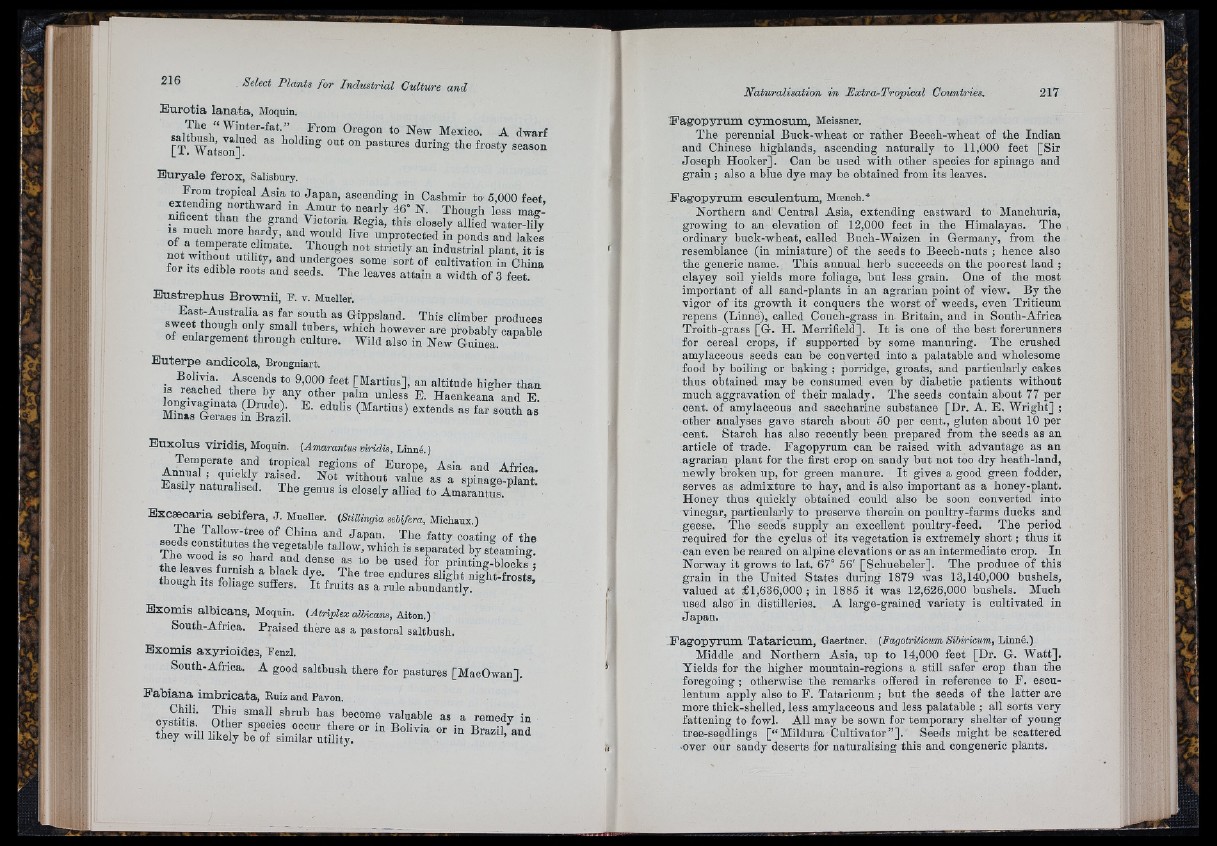
Il
i
il
Eurotia lanata, Moquin.
Oregon to New Mexico. A dwarf
[T. WatsInJ ^ °“ pastures during the frosty season
Euryale ferox, Salisbury.
From tropical Asia to Japan, ascending in Cashmir to 5,000 feet,
extending northward in Amur to nearly 46° N. Though less mag-
mficent than the grand Victoria Kegia, this closely allied water-lily
of T tem l lM I and would live unprotected in ponds and lakes
u L f ] Though not strictly an industrial plant, it is
fnr undergoes some sort of cultivation in China
r its edible roots and seeds. The leaves attain a width of 3 feet.
Bustrephus Brownii, F. v. Mueller.
far Gippsland. This climber produces
sweet though oniy small tubers, which however are probably capable
of enlargement through culture. Wild also in New Guinea.
Euterpe andícola, Brongniart.
is [Martius], an altitude higher than
s reached there by any other palm unless E. Haenkeani and E.
f c . o ™ K S i . * " • " <“ “ " a ■>
Buxolus viridis, Moquin. {Amarantus viridis, Linné. )
AuÜrr™'® and Africa.
J without value as a spinage-plant.
Easily naturalised. The genus is closely allied to Amarantus.
Bxcæcaria sebifera, J. Mueller. (StiUingia sebifera, Miohaux.)
The Tallow-tree o f China and Japan. The fatty coating of the
seeds constitutes the vegetable tallow, which is separated by steaming.
S e ! v r be nsed for printing-blocks
the leaves furnish a black dye. The tree ejidures slight night-frosts
though its foliage suffers. I t fruits as a rule abundantly. ’
Bxomis albicans, Moquin. {Atriplex albicans, Aiton.)
South-Africa. Praised there as a pastoral saltbush.
Bxomis axyrioides, Fenzi.
South-Africa. A good saltbush there for pastures [MacOwan].
Pabiana imbricata, Ruiz and Pavon.
cvSffli' nlíí® as a remedy in
'n ° * e r species occur there or in Bolivia or in Brazil, and
they will likely be of similar utility. ’
E a g o p y rum c ym o sum , Meissner.
The perennial Buck-wheat or rather Beech-wheat of the Indian
and Chinese highlands, ascending naturally to 11,000 feet [S ir
Joseph Hooker]. Can be used with other species for spinage and
grain ; also a blue dye may be obtained from its leaves.
E a g o p y rum e so u le n tum , Moench.*
Northern and Central Asia, extending eastward to Manchuria,
growing to an elevation of 12,000 feet in the Himalayas. The
ordinary buck-wheat, called Buch-Waizen in Germany, from the
resembianoe (in miniature) of the seeds to Beech-nuts ; hence also
the generic name. This annual herb succeeds on the poorest land ;
clayey soil yields more foliage, but less grain. One of the most
important of all sand-plants in an agrarian point of view. By the
vigor of its growth it conquers the worst of weeds, even Triticum
repens (Linné), called Couch-grass in Britain, and in South-Africa
Troith-grass [G . H. Merrifield]. I t is one of the best forerunners
for cereal crops, if supported by some manuring. The crushed
amylaceous seeds can be converted into a palatable and wholesome
food by boiling or baking ; porridge, groats, and particularly cakes
thus obtained may be consumed even by diabetic patients without
much aggravation of their malady. The seeds contain about 77 per
cent, of amylaceous and saccharine substance [Dr. A. E. Wright] ;
other analyses gave starch about 50 per cent., gluten about 10 per
cent. Starch has also recently been prepared from the seeds as an
article of trade. Eagopyrum can be raised with advantage as an
agrarian plant for the first crop on sandy but not too dry heath-land,
newly broken up, for green manure. I t gives a good green fodder,
serves as admixture to hay, and is also important as a honey-plant.
Honey thus quickly obtained could also be soon converted into
vinegar, particularly to preserve therein on poultry-farms ducks and
geese. The seeds supply an excellent poultry-feed. The period
required for the cyclus of its vegetation is extremely short ; thus it
can even be reared on alpine elevations or as an intermediate crop. In
Norway it grows to lat. 67° 56' [Schuebeler]. The produce of this
grain in the United States during 1879 was 13,140,000 bushels,
valued a t £1,636,000 ; in 1885 it was 12,626,000 bushels. Much
used also in distilleries. A large-grained variety is cultivated in
Japan.
Eagfopjrnim T a ta r ic um , Gaertner. {Fagotriticum SiUricum, JAmiê.)
Middle and Northern Asia, up to 14,000 feet [Dr. G. W a tt].
Yields for the higher mountain-regions a still safer crop than the
foregoing ; otherwise the remarks offered in reference to E. escu-
lentum apply also to F . Tataricum ; but the seeds of the latter are
more thick-shelled, less amylaceous and less palatable : all sorts very
fattening to fowl. All may be sown for temporary shelter of young
tree-seedlings [ “ Mildura Cultivator”]. Seeds might be scattered
■over our sandy deserts for naturalising this and congeneric plants.